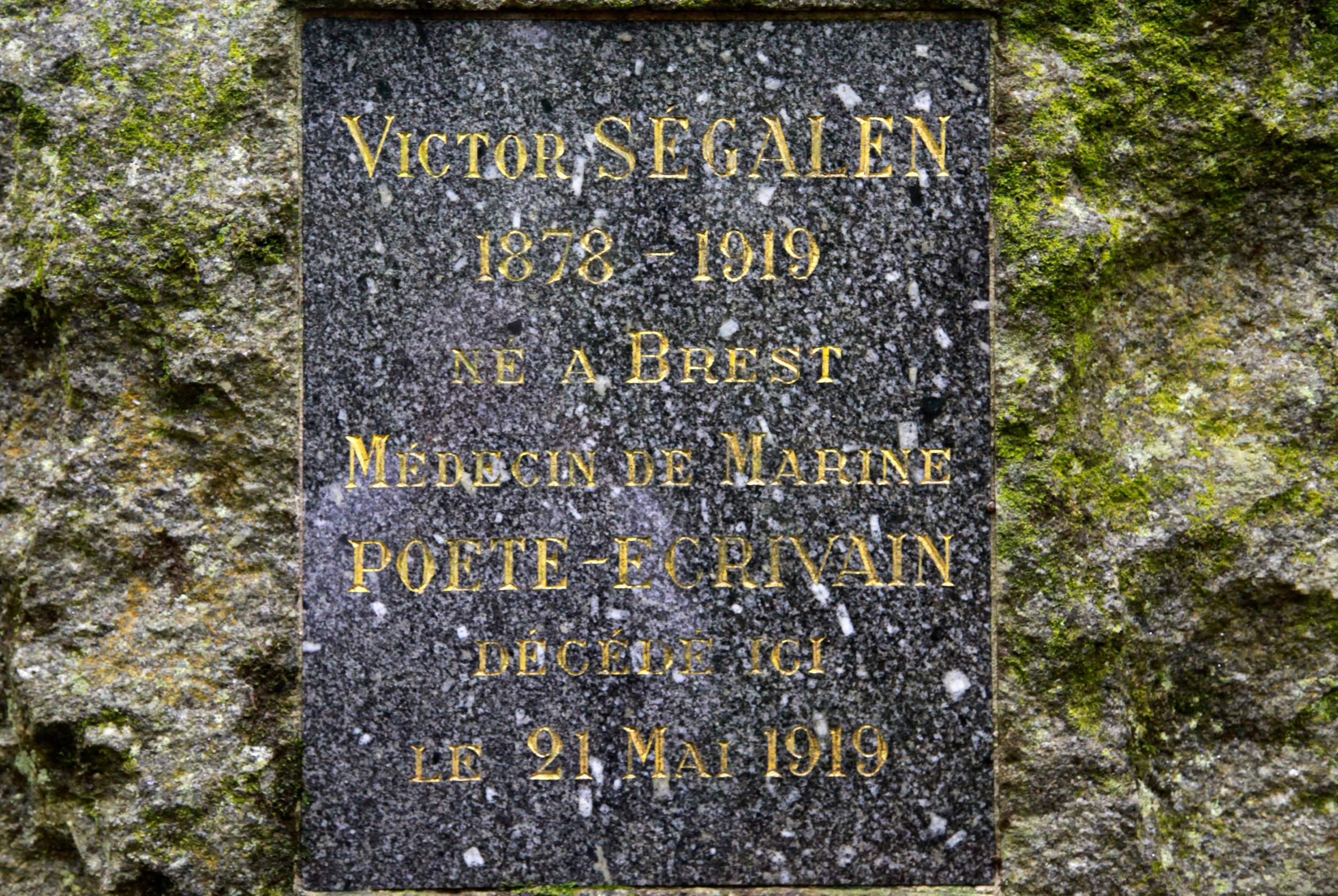THE SOURCE OF INSPIRATION: VICTOR SEGALEN & XI'AN, 2014
Victor Segalen: portrait by Georges-Daniel de Monfried; in a private collection, used with permission in the film.
The genesis of this 60 minute documentary occurred when I asked questions about some old photographs of Xi’an, in particular of the mausoleum of the First Emperor, Qinshihuang, and learned that they had been taken by a Frenchman. I discovered that his name was Victor Segalen, who had visited the city twice, in 1909 and again in 1914. I began to read his works, and was astonished by the diversity of his interests and expertise. He was by profession the doctor in the French Navy, but had always been interested in literature and came to write books of poems, novels and studies of China and its archaeology. In addition he was a talented musician who corresponded with Debussy and inspired one of the composer’s Images, studied Chinese with one of the greatest French sinologists, Édouard Chavannes, was a talented draughtsman, became an expert archaeologist, and spent several years in different parts of China, in Shaanxi, Beijing, Anyang, Tianjin, Shanhaiguan and later in Shanghai. A genuine polymath and absolute genius. Perhaps that was a problem as far as his reputation is concerned, since he covered so many fields in minor but significant ways that scholars would have difficulty in placing him. But today his literary work is enjoying a comeback, and many are in print in news editions as well as a large two-volume selection of his letters.
At first I took some photographs, intending to write a book, and shot a few movie scenes for my notes using an iPad. But gradually the book became more visual, and I decided the only way do it was as a film. It was made as a co-production with Shaanxi Eton Cultural Exchange Co. Ltd.
Tanguy Tower & castle protecting harbour entrance
Segalen was born in 1879 in Brest, a city on the extreme north-west coast of France which was then the most important naval base in the country and hosted the École Navale and a famous Naval Hospital. It was one of the safest harbours in Europe, on the River Penfeld, but but the Roads of Brest that open directly to the Atlantic Ocean. The sea, and the world it opens up, were a natural destination for the young men of Brest. Segalen’s owngreat-uncle had been a naval doctor who visited China, and his father worked for the navy. During his life, Segalen often met fellow naval officers and doctors from his hometown, from Bordeaux to Saigon, San Francisco, Colombo and Shanghai. He was rejected as a regular naval officer as a result of his short-sightedness, so embarked on a career as a medical officer.
Photo of the Four Treasures used in the film
On the way to his first posting the young officer was struck by typhoid fever and obliged to recover at a hospital in San Francisco. On Friday 28 November 1902 he visited Chinatown and wrote a letter to his parents in which he speaks of being overwhelmed by his first experience of Chinese theatre. Later he wrote that of all the exotic theatre he had seen, nothing had more powerfully astonished him than the scenes he saw in San Francisco. It seems that already he sensed that he would later go to China, for in a sign of destiny he tells his parents that he had bought what the Chinese call the four treasures of the study: ink stone, ink, brush and paper. He especially admired what he called the “extraordinary paper”.
Although he was always devoted to his wife and family, China now inspired his imagination. He wrote to apply for a job with a Franco-Belgian consortium which had obtained a concession to continue the planned railway to Taiyuan southwards to Xi’an ,and possibly link up with the railway system in Sichuan and Yunnan. The line was never built, and no job was forthcoming. Never a man to give up easily, in 1908 Segalen decided to become what was known as a student-interpreter, for which he needed to pass a formal exam in Chinese. He began studying the written language by correspondence in Brest, with six lessons sent to him by Arnold Vissière, who was a professor at the École de Langues Orientale in Paris, and the author of the French phonetic system for transcribing Chinese - the equivalent of the Wade-Giles system in English - and later of a well-known textbook. Then he was given leave by the navy to do a three-month intensive course in Paris. During this extended stay he attended Vissière’s lectures in person. More importantly, he also met and studied with Chavannes, who was then Professor of Chinese at the Collège de France and had travelled widely in the country and translated key Chinese texts.
Following this, in 1909, Victor Segalen first travelled to China on a two-year official appointment.
Stèles, the original edition, Beijing, 1912
Three years later came the publication of Stèles, an original work in the Symbolist tradition of short poems based on the use of inscriptions on steles used by Chinese emperors. It was an extraordinary achievement. Segalen was now so absorbed by Chinese culture that he conceived his printed book of poems as an ancient Chinese volume, created from hand-made paper, bound in silk, and placed between wooden covers. He followed every detail obsessively as the book was printed at the workshop of the Lazarist friars and the northern cathedral in Beijing (known as Beitang). The copies were each numbered and limited to the Chinese symbolic - and imperial - number of 81. But it was more than just a book, rather a homage to Xi’an and imperial China. The proportions of the book derived from the Nestorian Stele in the Beilin Museum, while the text is set within black rectangles like the lines around many imperial edicts on steles, emulating Chinese inscriptions on the steles placed at tomb-sites - although the words are those of Segalen and not mere translations. The speaking voice behind the poems is that of a Chinese scholar, who can address the reader on a variety of themes such as chivalry, friendship, and virtue. These short poems, still in print in French and English, emulate Chinese inscriptions on the stele placed at tomb sites.
Segalen in Tianjin (third from the left, front row)
In the five years following his first expedition to Shaanxi and Gansu, Victor Segalen led a varied and significant life in China. When the pneumonic plague broke out in Manchuria in December 1910, he travelled to what was then the border town of Shanhaiguan, where the Great Wall meets the Bohai Sea, volunteering to take the place of another French doctor who had died of the plague as 40,000 lives were lost in about three months. For by family tradition and personal training he was first and foremost a doctor. In Shanhaiguan he was the officer responsible for a quarantine belt designed to prevent the plague coming further west, patrolling along the Great Wall from the sea to the mountains. As a result of his success in that task, he was appointed professor of medicine at Peiyang, now Tianjin University, where he taught a course on physiology. He and his family settled in Tianjin.
In 1914, he returned to Shaanxi on an archeological and photographic mission which produced the photos which had first inspired me.
Segalen stele in the Forest of Huelgoat
His life ended early, and mysteriously, when on a period of convalescence after the First World War he went to stay in a hotel in Huelgoat in the midst of an ancient and magical forest inland from Brest. The author and literary man continued to read, and sought solace in the works of Shakespeare. He died in the forest, on xxx 1919, with a copy of Hamlet in his hands, perhaps by accident and perhaps by choice. The event is commemorated by a Chinese-style stele.
The film was first shown to an invited audience of 120 experts and dignitaries in the ballroom of the Shangri-la Hotel in Xi'an, which was one of the sponsors.
Professor Shih Xing Bang, past President, now Honorary President, of the Shaanxi Archeological Institute, at the reception following the first showing of THE SOURCE OF INSPIRATION. He was interviewed in the film.
NOTE ON THE MAKING OF THE FILM
The film was shot on location in and around Xi’an, in Anyang, Beijing, Tianjin and Shanhaiguan, as well as in Brest and in the Forest of Huelgoat. Scholars were generous with their help, in particular Philippe Postel, of the University of Nantes, the co-editor of his letters and editor of a new edition of Stèles. Other interviews were recorded with archeologists, one an expert on the Tang dynasty and one the doyen of Shaanxi archeologists, then 91 (and still working now), as well as the Deputy Director of the Terracotta Warriors Museum.
Together with Wu Shanda as he wrote the calligraphy for the title of the film:
Wu Shanda, one of the leading calligraphers and painters in Xi'an, devised the title - whose English version is actually a translation of the four characters he wrote for the opening shot of the film.
One pleasing coincidence concerns the music of Debussy used in the soundtrack, from the five Images for piano. One of them, ‘Et la lune descend sur le temple qui fût’, was inspired by a long conversation with Segalen at Debussy’s home in Paris. I had always admired the recordings of the great Italian pianist and interpreter of Debussy, Arturo Benedetti Michelangeli, who I once had the privilege to hear in a concert in Milan. Having heard a version in MP3 online which sounded close to Michelangeli, I contacted the pianist, an American living in Italy called John Clement Anderson. He generously provided me with good quality recordings of all the Images, and a video of him playing ‘‘Et la lune descend…’ which I used in the film. I later discovered that he had been a pupil of Bruno Mezzena, who had himself studied under Michelangeli.
Listen to John Clement Anderson's recording of ‘Et la lune descend sur le temple qui fût’, the MP3 version of the recording used in the film soundtrack.









